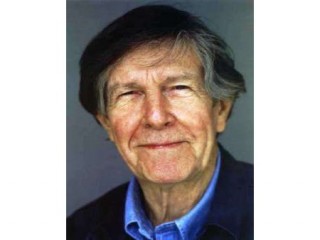
John Cage biography
Date of birth : 1912-09-05
Date of death : 1992-08-12
Birthplace : Los Angeles, California, U.S.
Nationality : American
Category : Famous Figures
Last modified : 2011-10-21
Credited as : musician, composer,
15 votes so far
John Cage is undeniably one of the most important composers of the twentieth century. He has broadened the definitions of music to include all types of sound.
John Milton Cage, Jr., was born on September 5, 1912, in Los Angeles, California. As a child he took piano lessons from his aunt. He attended Los Angeles High School, establishing the highest scholastic average in the school's history, and was valedictorian at his class's graduation in 1928. He enrolled in nearby Pomona College in Claremont, California, where he remained for two years. After withdrawing from Pomona, Cage traveled extensively in Europe and North Africa. He dabbled in architecture and painting and began composing music, using a complex mathematical system he designed to approximate the style of the eighteenth-century German composer Johann Sebastian Bach.
In 1931 Cage returned to California with no money or job. He supported himself by giving lectures on modern art and music. Through these lectures, he developed an interest in the music of Austrian-born composer Arnold Schoenberg. Cage studied with Richard Buhlig--the first American pianist to perform the music of Schoenberg--and then in New York City with Adolph Weiss, a former student of Schoenberg. He also attended classes taught at New York City's New School for Social Research by the composer Henry Cowell. In 1934, Cage began studying with Schoenberg privately in Los Angeles and attending his classes at the University of Southern California and the University of California, Los Angeles.
In the 1930s Cage began writing percussion music, and in 1938 he was asked by dancer Syvilla Fort to write the music for her dance, Bacchanale. Because of space limitations, a percussion ensemble could not be used. Unhindered, Cage was able to achieve the effect he desired by placing objects inside the piano, thus altering the sound of the strings. This innovation, influenced by Henry Cowell's work in which piano strings were stroked or strummed, became known as the "prepared piano." Cage's Sonatas and Interludes of 1946 to 1948 remains his most famous work for prepared piano.
In February of 1943 the League of Composers presented a concert of music written by Cage and others at the Museum of Modern Art in New York City. The concert was well received by critics and the public, and Cage's recognition as a leading avant-garde composer became widespread.
After his divorce in 1945 from Xenia Kashevaroff, whom he had married ten years earlier, Cage took an interest in Eastern thought. He studied with Indian philosopher Gita Sarabhai and was instructed in Zen Buddhism by D. T. Suzuki, a leading authority on Zen who taught at Columbia University. The influence of Eastern philosophy on Cage resulted in his experimentation in the early 1950s with "chance operations," in which the means of composition are chosen at random. Cage began using chance operations in order to let music speak for itself, rather than imposing personal taste or desire onto it. American composer Christian Wolff, a former student of Cage, explained the method of composing in a 1982 National Public Radio interview, stating, "what you're listening for is sound in combinations that are not usual, though, when you get right down to it, are not that different from what you hear if you really listen to the world around you."
The first piece Cage wrote using chance operations was Sixteen Dances, composed for the Merce Cunningham Dance Company in 1950. Another chance piece, composed in 1951, was Concerto for Prepared Piano and Chamber Orchestra. After 1950 Cage's chance compositions were based on the use of the I Ching, or "Book of Change," an ancient Chinese text containing hexagrams used for making predictions by tossing coins. Cage's first piece composed by using the I Ching was similarly called Music of Changes.
In the early 1950s Cage became aware that absolute silence was an impossibility; even the supposedly soundproof chamber he had visited at Harvard University revealed that he could hear his nervous system and circulation in operation. The result of this discovery was 4'33" (four minutes and thirty-three seconds), a piece in which the performer appears but does not play an instrument. Instead, the audience is encouraged to listen to the sounds around them. 4'33" was Cage's affirmation of the important role of nonintended sounds and remains perhaps his most famous work.
During the 1950s and 1960s Cage accepted teaching positions and visiting fellowships at several American universities. Meanwhile he composed Atlas Eclipticalis, an orchestral piece created by consulting astronomical charts he acquired at the Wesleyan University observatory, and HPSCHD (pronounced "harpsichord"), written in collaboration with University of Illinois composer Lejaren Hiller.
Since the late 1960s Cage has been devoted largely to eclecticism, either using elements from earlier works or combining previous ideas and methods with new ones. Perhaps most significant are the ambitious Etudes Australes for piano of 1974 to 1975, composed by tracing astronomical charts onto music paper; Child of Tree (1975) and its companion piece Branches (1976), in which contact microphones amplify the sounds of plants; and Roaratorio, an Irish Circus on Finnegans Wake (1979), which features bits of text from James Joyce's novel Finnegans Wake accompanied by a collage of music, particularly traditional Irish music. In 1987, Cage's first opera, Europera, premiered in Frankfurt, Germany.
The composer's death occurred on August 12, 1992 only weeks before a celebration of his 80th birthday organized in Frankfurt by the composer Walter Zimmermann and the musicologist Stefan Schaedler was due to take place.
















